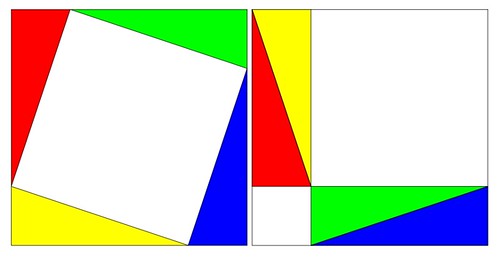To the Right, To the Right
When working geometry problems on the GMAT, you are certain to come across several that deal with right triangles and your old middle school friend, Pythagoras. Remember him? He was the a2 + b2 = c2 guy. While Pythagoras and his theorem won’t let you down, they will waste your time. Remember that you don’t have a calculator and sometimes squared numbers can get very large. You are also likely to make mistakes when working under the pressure of the test and you can’t go back to check your work once you move to the next question.
The good news is that right triangle problems often test one of several commonly seen special right triangles instead of arbitrary ones. If you have the dimensions of the special right triangles memorized and are on the lookout for them, you can save yourself some time and improve your accuracy. Let’s look at them.
Question 159 on page 174 of the Official Guide, 13th edition has a right triangle with a height of 5 and a hypotenuse of 13 (the distance from A to B). If you were aware of the a 5, 12, 13 is a special right triangle, you could instantly fill in the length of the base of the rudder and then split the shape into a rectangle and a right triangle to calculate the total area. The 5, 12, 13 right triangle is known as a Pythagorean triple. Another is the 3, 4, 5 right triangle. Be on the lookout for those (and their multiples, i.e. a 6, 8, 10) on your test.
Question 161 on the next page gives us an example of some other special right triangles. Here, the height is again 5, but the hypotenuse (the length from V to R) is 10, a relationship of x to 2x. Given those two measurements in a right triangle, the length of the third side will then have the relationship x√3. We can go even further and know automatically that the degree measures will be 30°, 60°, and 90°. Remember that the shortest side of a triangle is opposite the smallest angle and the longest side is opposite the biggest angle. So if you drew a line from V to R, the angle created by the height and hypotenuse would be 60° The roots in the answer choices should also be a clue to you that you may be dealing with one of these special right triangles, and in fact, the answer is A. The GMAT rarely requires you to solve out √3 (which you can estimate as 1.7) or √2 (which you can estimate as 1.4). Answer choice B has √2 in it, which is for a different special right triangle with the measurements of 45°, 45°, and 90° with sides in a relationship of x, x, x√2.
Remember, these special triangles won’t always be there, but having them in the back of your mind as a possibility can be a useful extra boost for your score.
Image courtesy of tobo with Creative Commons License

